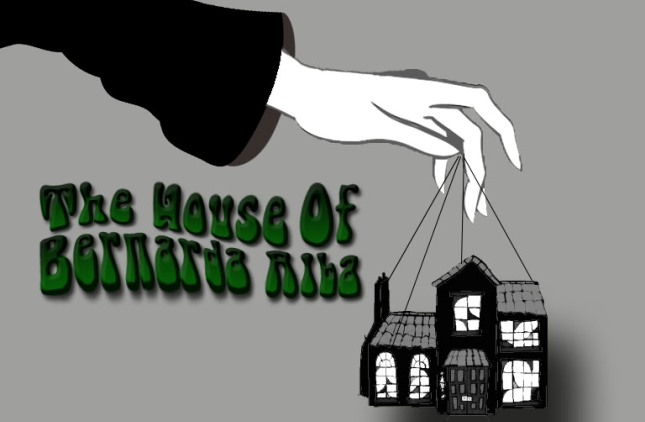“Theatre is poetry that gets up off the page and becomes human” ~ Federico Garcia Lorca
Set in a steamy summer in provincial Spain, 1930, THE HOUSE OF BERNARDA ALBA features five sisters, unmarried, ages 20 – 39, shut-in by force to mourn by their dictatorial mother, Bernarda (superbly rendered by Susan Mattson) following their father’s death, fanning themselves against the heat and oppression without so much as a breeze allowed in the house. No relations or communication with the opposite sex is permitted in strict observance of an archaic eight year mourning period which has been imposed upon the sisters in order to maintain appearances under the guise of family, and control. When it is revealed that the wealthy eldest sister Angustia is to be married to the handsome object of each sister’s deepest desire, Pepe el Romano, the simmering emotional intensity begins to boil…
La Poncia, the matriarch’s servant, given a deadpan wit and earthy wisdom by Cindy Nagle Walton, is realistic about the ‘Pepe’ situation astir, “They’re women without a man… In such cases even blood ties are forgotten.” in counter to Bernarda, powerfully portrayed by Susan Mattson, who blinded by pride, believes against blood that she can bleach the instinct of sex out of her daughters by entombing them in the house, the name “Alba” suggesting “white”. Mattson delivers her lines right on target, especially when Bernarda misfires, with “It wasn’t for want of trying. But we women are poor shots.”, which had quite an impact on the audience. Martirio (Spanish for “martyrdom”) is suffused with great spirit by the talented and lovely Elise D’Avella, and Raquel N. Perez imbues Magdalena with excellent emotional articulation, while Rosaleen Gallagher rounds out Amelia with nice touches. The name Angustias translates as “anguishes” or “heartache” in English and Sue Abla succeeds beautifully in projecting the feeling of the eldest daughter’s inner dolor to the audience. Elizabeth Hall sparks the youngest daughter and closest rival to Pepe’s affections, Adela (“bittersweet” in Spanish), with a love of the stars and a flash of will that is believable when she exclaims, “… I can bring a wild stallion to its knees by lifting my little finger.”, in contrast to her sisters who are stifled by their mother’s own means of suffocation. Barbara M. Bibby is mesmerizing as Bernarda’s mad but robust octogenarian mother, Maria Josefa, who periodically escapes from her locked room. Maria Josefa is dressed in white and croons and seems to represent the circle of life, an ouroboros, warning the household inhabitants, “…You’ll have white hair…”. The role of the servant Blanca (white, again) is increased by Cathy Gibbon Mostek’s fabulous physicality and facial expressions, and Linda Haentze brings heart to role of Prudencia. Suzanne Oldham, Abby Oldham and Sally Gallagher enrich the cast in their respective roles as the Beggar Woman, Little Girl and Criada. Through excellent cast collaboration and repartee, dramatic tension is effectively increased by degrees by until the lid of this pressure-cooker of a house explodes from the stage.
That which is not seen in this production, as directed by Thomas-Robert Irvin, is nonetheless given strong presence; The male characters, particularly that of Pepe, and a stoning, although unseen, are made palpable through insinuation and the wonderful expressivity of the actresses on stage. Mental imagery is also assisted by the use of sound (Jack Gallagher) as in the case of the white stallion kicking the stall in his furious need to stud and the facial and physical reactions of the players. Symbolism continues to play a rich role throughout THE HOUSE OF BERNARDA ALBA as witnessed by the naming of characters, use of the color green which connotes desire, freedom, life and death, in contrast to a palate of black, white and gray color scheme in costume (Cindy Nagle Walton, Thomas-Robert Irvin, Sue Abla, Raquel N. Perez, and cast) and a splendidly spartan set (Timothy P. Oskin).
Note: Federico Garcia Lorca’s 1936 tragedy of repression, and the human need for freedom may have been based in part on a nearby distant cousin by the name of Frasquita Alba Sierra who always wore black, ruling over her single daughters in a tyrannical fashion; It was subtitled “A drama of women in the villages of Spain”, and did not premiere until 1945 in Buenos Aires, several years later in the rulership of Franco, nearly 10 years after Lorca’s murder.
THE HOUSE OF BERNARDA ALBA
by Federico Garcia Lorca
Directed by Thomas-Robert Irvin
July 18 – 27, 2013
Spotlight Theatre
Swarthmore United Methodist Church
129 Park Avenue
Swarthmore, PA 19081
610-328-1079
www.mnplayers.co


